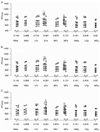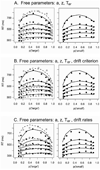A model of the go/no-go task
- PMID: 17696690
- PMCID: PMC2701630
- DOI: 10.1037/0096-3445.136.3.389
A model of the go/no-go task
Abstract
In this article, the first explicit, theory-based comparison of 2-choice and go/no-go variants of 3 experimental tasks is presented. Prior research has questioned whether the underlying core-information processing is different for the 2 variants of a task or whether they differ mostly in response demands. The authors examined 4 different diffusion models for the go/no-go variant of each task along with a standard diffusion model for the 2-choice variant (R. Ratcliff, 1978). The 2-choice and the go/no-go models were fit to data from 4 lexical decision experiments, 1 numerosity discrimination experiment, and 1 recognition memory experiment, each with 2-choice and go/no-go variants. The models that assumed an implicit decision criterion for no-go responses produced better fits than models that did not. The best model was one in which only response criteria and the nondecisional components of processing changed between the 2 variants, supporting the view that the core information on which decisions are based is not different between them.
Figures







References
-
- Balota DA, Spieler DH. Lexicality, frequency and repetition effects: Beyond measures of central tendency. Journal of Experimental Psychology: General. 1999;128:32–55. - PubMed
-
- Boldini A, Russo R, Avons SE. One process is not enough! A speed-accuracy tradeoff study of recognition memory. Psychonomic Bulletin & Review. 2004;11:353–361. - PubMed
-
- Busemeyer JR, Townsend JT. Decision field theory: A dynamic cognitive approach to decision making. Psychological Review. 1993;100:432–459. - PubMed
-
- Cattell J. The time taken up by cerebral operations. Mind. 1886;11:277–282. 524–538.

